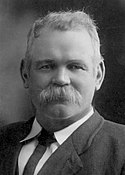Regierung Watson
Die Regierung Watson war die dritte Regierung des Commonwealth of Australia. Sie amtierte vom 27. April 1904 bis zum 17. August 1904. Sie war die erste australische Regierung unter Führung der Labor Party.
Nachdem die von Alfred Deakin geführte Minderheitsregierung der Protectionist Party, bei der Abstimmung zur conciliation and arbitration bill (eine Schlichtung und Schiedsgerichtsbarkeit in Arbeitsfragen), die Unterstützung der Labor Party verlor, reichte Deakin seinen Rücktritt ein und bat den Generalgouverneur Lord Northcote, den Vorsitzenden der Labor Partei, Chris Watson, mit der Bildung der neuen Regierung zu beauftragen.[1][2]
Die Regierung Watson bestand – mit Ausnahme des Generalstaatsanwalts Higgins, der der Protectionist Party angehörte[3] – nur aus Mitgliedern der Labour Party, die mit 22 von 75 Sitzen nur drittstärkste Fraktion im Repräsentantenhaus stellte. Sie war auf die parlamentarische Unterstützung der Protectionist Party angewiesen, die als stärkste Partei 26 Abgeordnete stellte. Auch diese Regierung scheiterte, wie schon ihre Vorgängerregierung an einem Dissens über dieconciliation and arbitration bill. Ihr folgte eine Koalitionsregierung von Free Trade Party und Protectionist Party unter Premierminister George Reid.[4]
Ministerliste
| Amt | Minister | Amtszeit | Bild |
|---|---|---|---|
| Premierminister und Schatzminister | Chris Watson | 27. April 1904 – 17. August 1904 | |
| Außenminister | Billy Hughes | 27. April 1904 – 17. August 1904 | |
| Generalstaatsanwalt | Henry Bournes Higgins | 27. April 1904 – 17. August 1904 | |
| Innenminister | Lee Batchelor | 27. April 1904 – 17. August 1904 | |
| Minister für Handel und Zölle | Andrew Fisher | 27. April 1904 – 17. August 1904 | |
| Verteidigungsminister | Anderson Dawson | 27. April 1904 – 17. August 1904 | |
| Generalpostmeister | Hugh Mahon | 27. April 1904 – 17. August 1904 | |
| Vizepräsident des Executive Council | Gregor McGregor | 27. April 1904 – 17. August 1904 |
Weblinks
- Parliamentary Handbook for the 45th Parliament. (PDF; 13,4 MB) Part 6: Historical information on the Australian Parliament – Ministries and Cabinets. Parliament of Australia, S. 519, abgerufen am 13. April 2019 (englisch).
Einzelnachweise
- ↑ R. Norris: Deakin, Alfred (1856–1919). In: Douglas Pike (Hrsg.): Australian Dictionary of Biography. Band 8. Melbourne University Press, Carlton (Victoria) 1981, ISBN 0-522-84219-4 (englisch).
- ↑ Bede Nairn: Watson, John Christian (Chris) (1867–1941). In: Douglas Pike (Hrsg.): Australian Dictionary of Biography. Band 12. Melbourne University Press, Carlton (Victoria) 1990, ISBN 0-522-84437-5 (englisch).
- ↑ Parliamentary Handbook for the 45th Parliament. (PDF; 13,4 MB) Part 6: Historical information on the Australian Parliament – Members of the House of Representatives since 1901. Parliament of Australia, S. 473, abgerufen am 13. April 2019 (englisch).
- ↑ W. G. McMinn: Reid, Sir George Houstoun (1845–1918). In: Douglas Pike (Hrsg.): Australian Dictionary of Biography. Band 11. Melbourne University Press, Carlton (Victoria) 1988, ISBN 0-522-84380-8 (englisch).
Auf dieser Seite verwendete Medien
Chris Watson, Prime Minister of Australia
Photograph of members of the Watson Ministry. Back row (L-R): Andrew Fisher, Minister for Trade and Customs; Anderson Dawson, Minister for Defence; Gregor McGregor, Vice-President of the Executive Council; Hugh Mahon, Postmaster-General. Front row (L-R): Henry Bournes Higgins, Attorney-General; Chris Watson, Prime Minister; Lord Northcote, Governor-General; Billy Hughes, Minister for External Affairs; Lee Batchelor, Minister for Home Affairs.
Andrew Fisher, ca. 1904
Portrait of H. B. Higgins, 1851-1929, Victorian federation leader and President of Arbitration Court.
This image shows a photograph of Gregor McGregor, politician of Victoria, Australia, taken in 1908.
Commonwealth Coat of Arms of Australia granted by Royal Warrant signed by King George V on 19 September 1912.
IMPORTANT:This image is an artist's interpretation of the original (1912) official version of the Commonwealth Coat of Arms shown in Commons on the Australian coat of arms page. A variant of the original, with a transparent background, is shown on this page.
| “ | Quarterly of six, the first quarter Argent a Cross Gules charged with a Lion passant guardant between on each limb a Mullet of eight points Or; the second Azure five Mullets, one of eight, two of seven, one of six and one of five points of the first (representing the Constellation of the Southern Cross) ensigned with an Imperial Crown proper; the third of the first a Maltese Cross of the fourth, surmounted by a like Imperial Crown; the fourth of the third, on a Perch wreathed Vert and Gules an Australian Piping Shrike displayed also proper; the fifth also Or a Swan naiant to the sinister Sable; the last of the first, a Lion passant of the second, the whole within a Bordure Ermine; for the Crest on a Wreath Or and Azure A Seven-pointed Star Or, and for Supporters dexter a Kangaroo, sinister an Emu, both proper. | ” |


















